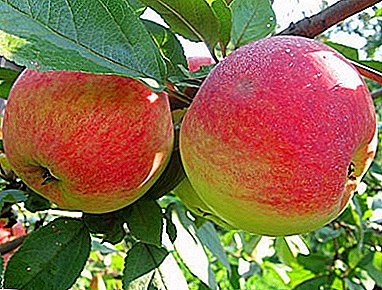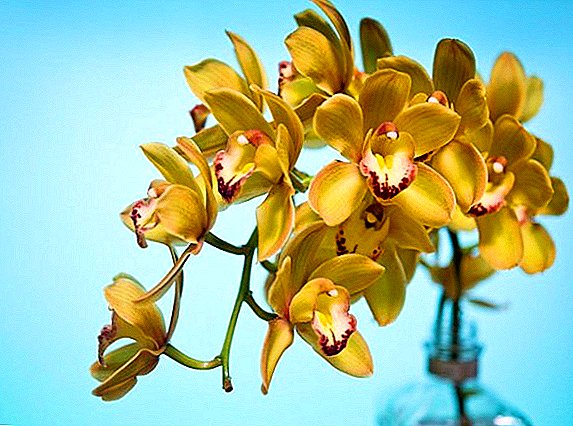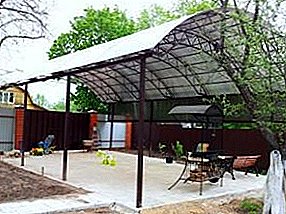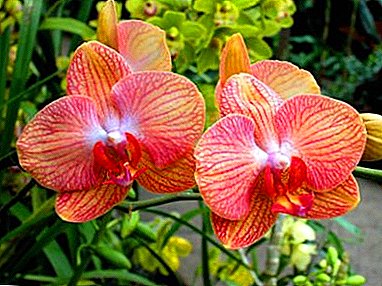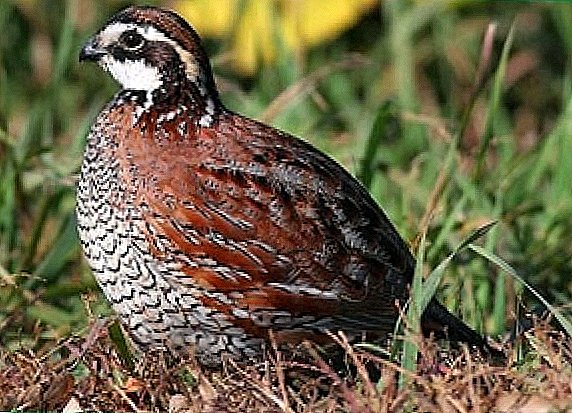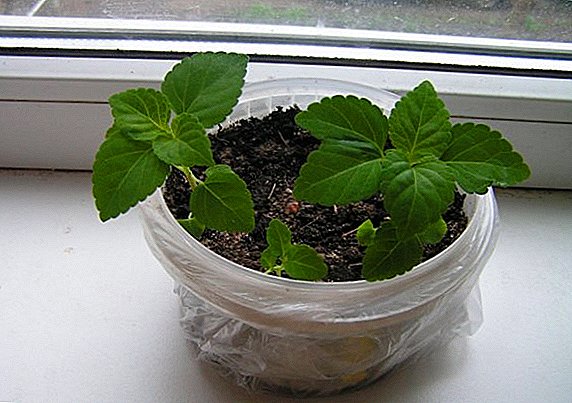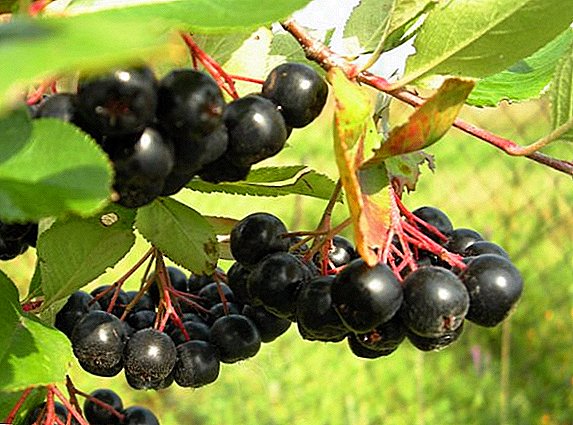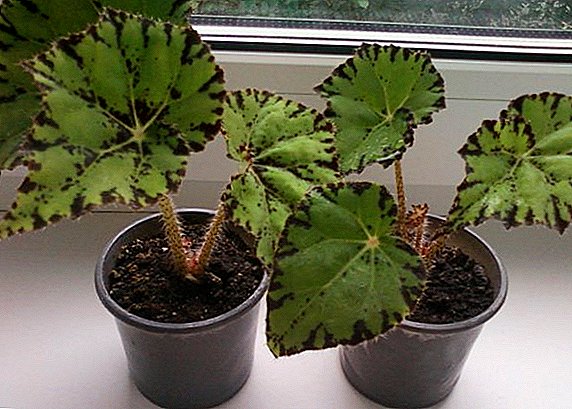 Begonia is a popular houseplant that is actively grown by growers from different countries. Among the most unusual and at the same time very attractive varieties of such a flower, the tiger plant is particularly notable, which got its name for its unusual color of leaves. We invite you to learn more about this exotic guest, paying particular attention to the peculiarities of his cultivation at home.
Begonia is a popular houseplant that is actively grown by growers from different countries. Among the most unusual and at the same time very attractive varieties of such a flower, the tiger plant is particularly notable, which got its name for its unusual color of leaves. We invite you to learn more about this exotic guest, paying particular attention to the peculiarities of his cultivation at home.
Plant description
Tiger begonia can often be found under the names "Bauer begonia" or "tiger", but in any case it is the same plant, with a branched stem (up to 35 cm in height) and heart-shaped leaves, with characteristic notches on the edges. On average, the length of the leaf plate does not exceed 6-8 cm, and its color attracts the eye with brownish and light green spots, which stand out very well on a dark green base. It is for the high decorativeness of the leaves that the plant is so valued by the growers, since winter flowering does not make this begonia too elegant.  Moreover, many flower growers immediately remove the flowers that appear so that they do not pull the juices out of the green mass. It is noteworthy that white inflorescences germinate directly from the root system of the plant, part of which is located above the surface of the substrate. It will not be possible to meet the tiger begonia in the natural environment, since in 1970 it was obtained by breeding, thanks to the efforts of the German scientist R. Bauer.
Moreover, many flower growers immediately remove the flowers that appear so that they do not pull the juices out of the green mass. It is noteworthy that white inflorescences germinate directly from the root system of the plant, part of which is located above the surface of the substrate. It will not be possible to meet the tiger begonia in the natural environment, since in 1970 it was obtained by breeding, thanks to the efforts of the German scientist R. Bauer.
Did you know? The first mention of the begonias is associated with the name of the French botanist Charles Plumier, who participated in the scientific expedition of 1687 to the Antilles. It was he who discovered a new species of plants in the territory of the West Indies, and in 1690 the flower was called "begonia".
Necessary conditions and care at home
Each houseplant requires an individual approach and selection of appropriate conditions, especially if we are talking about tropical varieties that are poorly adapted to the conditions of an average climatic region. Despite the fact that Bauer's begonia cannot be called a too problematic representative of exotic flora, everyone should be aware of the nuances of its home cultivation.
Lighting
The best solution for placing pots with begonias will be the window sills of south-western and south-eastern windows, since in organizing the lighting of a plant you should always adhere to the "golden mean". Direct and very bright sunlight will contribute to the burning of sheet plates, and with their lack will suffer the overall decorativeness of begonias.  In the summer, a good place to grow an exotic flower will be a closed balcony or terrace, i.e. a cool and slightly pristine place, protected from drafts.
In the summer, a good place to grow an exotic flower will be a closed balcony or terrace, i.e. a cool and slightly pristine place, protected from drafts.
Air temperature and humidity
Given the tropical origin of most types of begonias, it is not surprising that they all need high humidity. This also applies to the hybrid tiger variety, which feels good only if these indicators exceed the value of 50-60%. As for temperature, the optimal indicators will be values within + 15 ... + 26 ° C, depending on the season.
Watering
In the warm season (from mid-spring to late autumn), tiger begonia is watered every 2-3 days, focusing on the condition of the upper soil layer (it should always be slightly wet). For irrigation, only soft and settled water at room temperature is ideal, and when choosing a method for applying a liquid, make sure that moisture does not fall on the leaves of the plant.
Important! Over-wetting of the soil is dangerous even for tropical plants, so if a few hours after the procedure in the pan is still fluid, it should definitely be drained.
In winter, the tiger begonia is at rest, therefore it is advisable to reduce the regularity of irrigation to 1 time per week, however, only if the indoor temperature is at + 15 ° C or slightly lower. Begonia can not be sprayed, but to increase the humidity, the pot can be put on a tray with moistened pebbles or wet moss. In extreme cases, it will be useful to place an open container with water next to the flower. 
Top dressing
Begonia fertilizer season begins with the arrival of spring and lasts throughout the summer period, with regularity no more than once a month. In winter, the soil is fertilized either once every 2 months, or stop feeding until the very spring. Optimal indicators of plant growth and development can be achieved with the help of complex mineral compositions for indoor flowers, however, it is desirable to reduce the dosage recommended by the manufacturer by 2 times.
Pruning
Pruning begonias is performed not only for sanitary purposes, but also for transplanting an adult plant when it is necessary to renew it. To make the root system adapt more quickly to new conditions, the flower is taken out of the pot and the roots are cut, leaving only their upper part and leaves. Sometimes growers remove some leaf plates.
Learn how to care for the royal begonia at home.
Transfer
A transplant of young plants is performed every year, in early spring, and it is enough to take adult specimens to a new pot no more than once every 2-3 years.  Without a transplant, the plant's decorative effect will significantly decrease, so do not ignore the recommendations for the procedure:
Without a transplant, the plant's decorative effect will significantly decrease, so do not ignore the recommendations for the procedure:
- First, prepare a new suitable pot (the material does not matter), the diameter of which will be 2-3 cm more than the previous one.
- Pour a centimeter layer of expanded clay or other drainage material into it, lay a thin layer of peat moss on top of it and fill the container with half the volume of the prepared substrate: either with ready-made soil for begonias, or independently prepared mixture of equal proportions of peat, perlite, humus and coarse sand .
- Remove the plant from the old planting capacity and, after cutting the roots, place it in a new one, finally filling it with the remaining substrate.
Important! Do not fill the pot completely. The roots of tiger begonia very quickly crawl onto the surface of the substrate, which is why they constantly have to fall asleep with soil. The optimal solution is 2 cm of free space from the ground to the edge of the pot.After transplantation, it is advisable to take out the begonia in a dark room, leaving it there for at least a day. In the future, the pot can be returned to its original place.
Video: how to transplant begonia in a new pot
Breeding
The reproduction of the tiger begonia is possible either by vegetative means (cutting or dividing the bush), or by the seed method, although in the latter case one should not expect very fast germination results. Consider each of these options in more detail.
Cuttings
In the case of cuttings in this case, perfectly suitable leaves of medium size, completely healthy looking. In cut form, they must have a stem of at least 5 cm in length. It can be rooted in water, and then immediately planted in a soil substrate. It is easy to prepare suitable soil: for 1 part of leaf (sod) land, you need to take the same amount of sand and peat. It is advisable to moisten the soil before directly planting the leaf.
Read also about how to care for begonia elatior.
The sequence of all actions performed is as follows:
- Cut the selected sheet with a sharp and disinfected knife at an angle of 45 °.
- Place it in a small glass or a vase, but only so that the petiole does not touch the bottom (this leads to decay).
- Leave the leaf for rooting in a warm and shade room until your own root system appears.
- After a few weeks, the young plant can be transplanted into the prepared substrate.
 Airing the future of the plant is carried out daily, but the soil moistening is possible only with its full drying. Sprouting cuttings in the ground, you can reduce the temperature in the room to + 17 ... +19 ° C. Rooting will take 1-1.5 months.
Airing the future of the plant is carried out daily, but the soil moistening is possible only with its full drying. Sprouting cuttings in the ground, you can reduce the temperature in the room to + 17 ... +19 ° C. Rooting will take 1-1.5 months.Dividing bush
The division of the bush begonias - another simple way to get new plants from the mother flower. It is usually performed during rejuvenation, when the root system already has to be taken out of the substrate. However, if you need to divide a flower up to this point, you can not get it from the tank, but simply cut the desired part, deepening the knife into the soil to the desired depth. The tool used must be fairly sharp, so as not to leave barbs on the remaining maternal plant.
Did you know? In Asian countries, begonia tubers are eaten by adding them to meals and drinks. They have a pleasant citrus aroma and add a pleasant sourness to various culinary masterpieces.
The above-described substrate is well suited for the role of soil, and as a container for sprouting young plants, plastic disposable cups can be prepared, at the bottom of which it is desirable to place crushed foam or any other drainage material. The withdrawn part of the plant is placed in a recess in the bedded substrate and, sprinkled with the rest of the ground, covered with a plastic bag.  To speed up the germination of rhizomes on the separated part, it is useful to soak it in the root growth stimulator for 1-2 minutes before transplanting.
To speed up the germination of rhizomes on the separated part, it is useful to soak it in the root growth stimulator for 1-2 minutes before transplanting.
Growing from seed
This method of breeding plants is not as popular as the previous ones, but still used by growers to produce new begonias. Planting material can be purchased in almost any flower shop, where it is usually presented in two forms: regular (without additional processing) and granulated (in the form of dragees).
We recommend that you learn more about the cultivation of tuberous begonia.
The last option is much easier to work with, however, the landing plan in any case provides for the implementation of standard actions (sowing of seeds is done in early spring):
- Pre-treatment of seed material with a one-percent solution of potassium permanganate (begonia seeds are soaked in solution for 30-45 minutes, after which they are washed well under running water).
- Sowing seeds in peat moistened tablets laid out on a pallet (after planting the pallet must be covered with glass or plastic film).
 As soon as 3 true leaves are formed on young seedlings, a pick can be performed by planting each of them in separate containers with suitable soil (the soil mixture used for transplanting adult plants will do). 2 months after the previous picking, young begonias can be swooped a second time, but already in permanent pots.
As soon as 3 true leaves are formed on young seedlings, a pick can be performed by planting each of them in separate containers with suitable soil (the soil mixture used for transplanting adult plants will do). 2 months after the previous picking, young begonias can be swooped a second time, but already in permanent pots.Difficulty growing
Having clearly planned all your actions to take care of indoor plants, there will be no problems with begonias, but a violation of a suitable irrigation regime or conditions for the maintenance of flowers may well lead to the appearance of diseases and pests. Consider the main possible troubles and how to eliminate them.
Diseases
In the natural habitat of begonia is located on well-blown areas, therefore the heap placement of the tiger variety on the window sill can provoke rotting of the rhizome or the development of pathogenic microflora on the stem part. You can determine the presence of a problem by the appearance of a gray plaque on the surface of the rhizome of a plant, and in order to normalize the condition of the flower, it is necessary to reduce watering for a while.
Important! With a massive bacterial blotch, saving the begonia is no longer possible, and the only way out is to throw the flower away.
In case of a large-scale lesion, it will have to be treated with one of the popular fungicidal preparations: for example, 0.1% solution of Fundazol will help in the fight against powdery mildew; oxychloride. 
Pests
Among insect pests, increased attention to the tiger begonia is distinguished by scythos, mealybugs, spider mites, aphids and felts, which actively feed on plant sap. Favorable conditions for their development and reproduction will be dried indoor air, disruption of irrigation, as well as the absence of a quarantine period after the purchase of new plants.
You will be interested to know about the pests and diseases of begonias.
Some popular recipes (for example, soap solution) can be effective in pest control, but most often one has to use special insecticidal preparations: for example, Actellic, Aktara or Decis. The method of application and the desired dosage of the composition are always indicated on the package.
Signs and superstitions about the flower
Many superstitions and beliefs are associated with begonia (not necessarily tiger), which not all growers pay attention to.  The most famous include the following:
The most famous include the following:
- Begonia is a great homemade plant for those who want to end their past and start a new life. The plant will help get rid of the desire to go back and remove unnecessary images from memory.
- Useful flower will be for sick people, especially if it is close to the bed.
- Begonia will help lonely people to meet their soul mate, and for couples the bush will be a great help in conflict situations, because it helps to increase mutual understanding.
Learn more about the diversity of begonias.
Believe it all or not - a personal decision of each grower, but otherwise the tiger begonia will be a good solution for improving the interior of the room, especially if you are used to dealing with houseplants and caring for them does not bother you.




